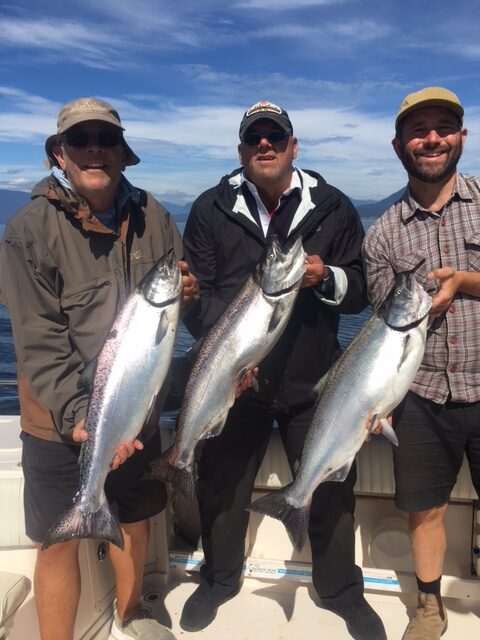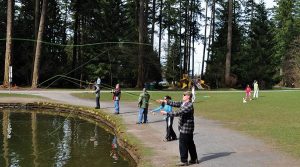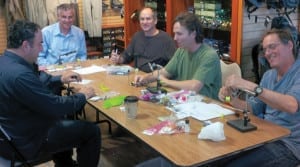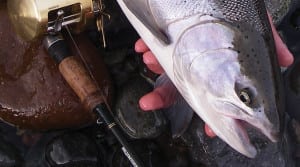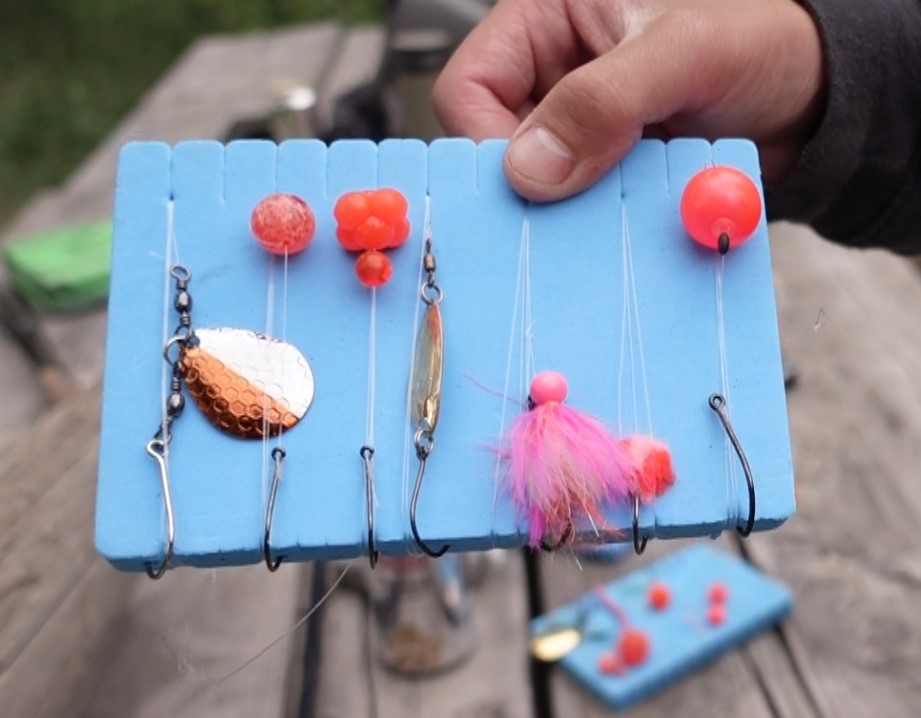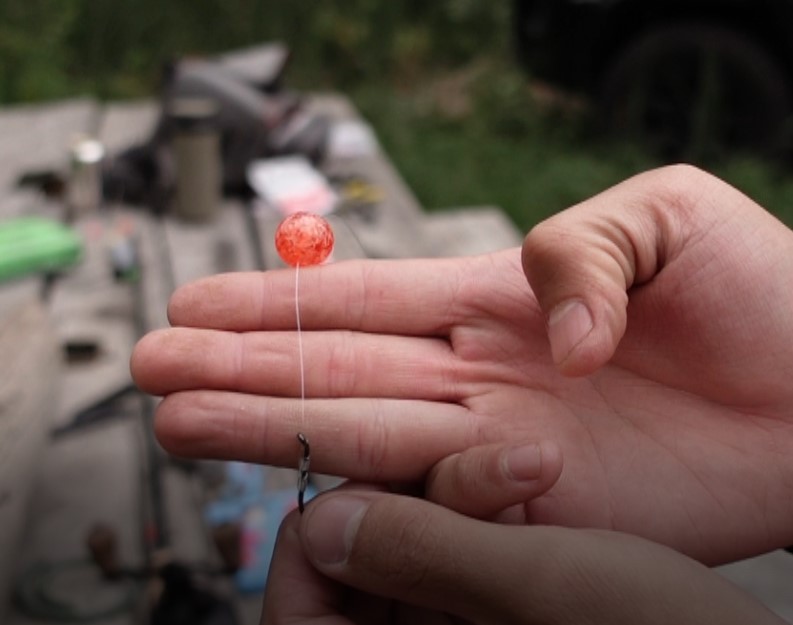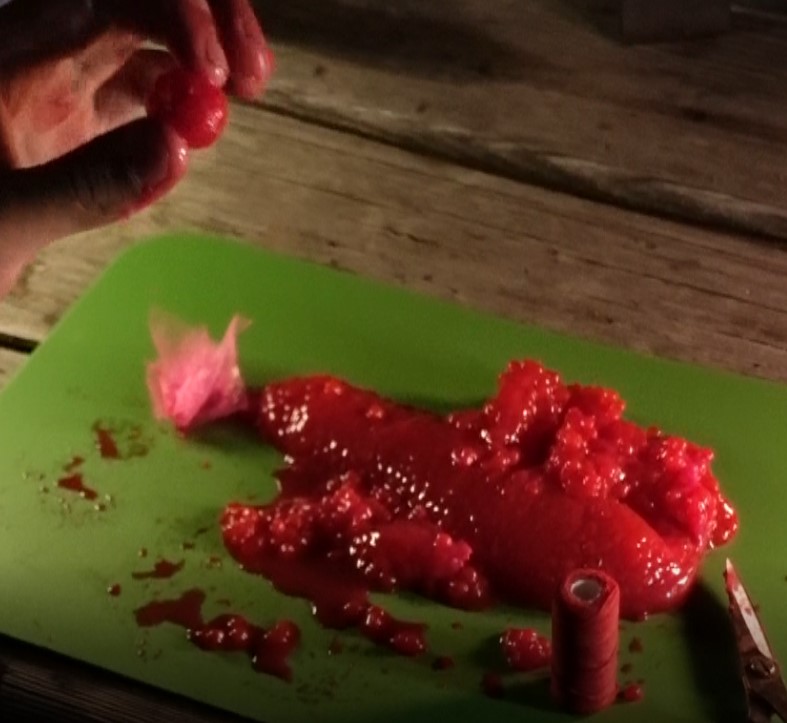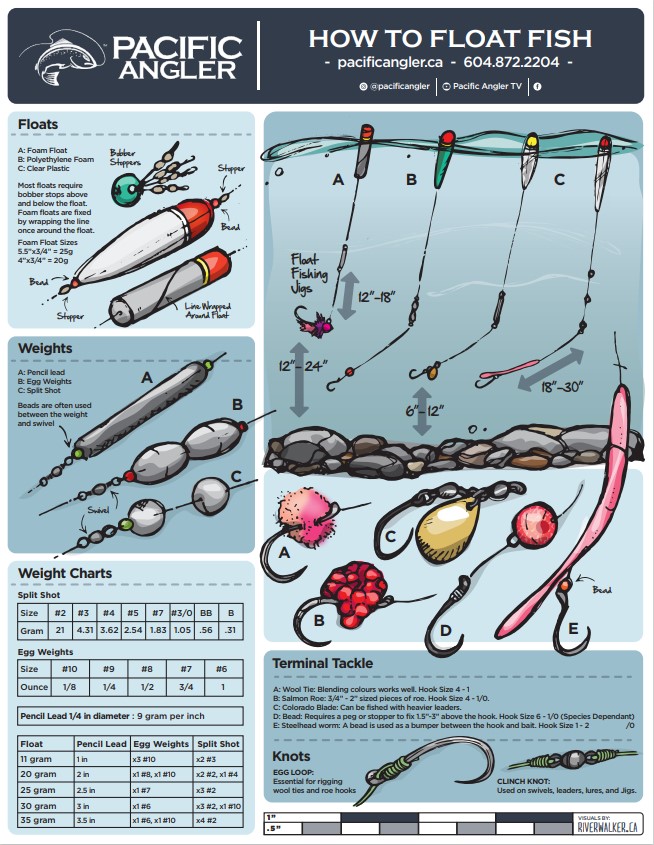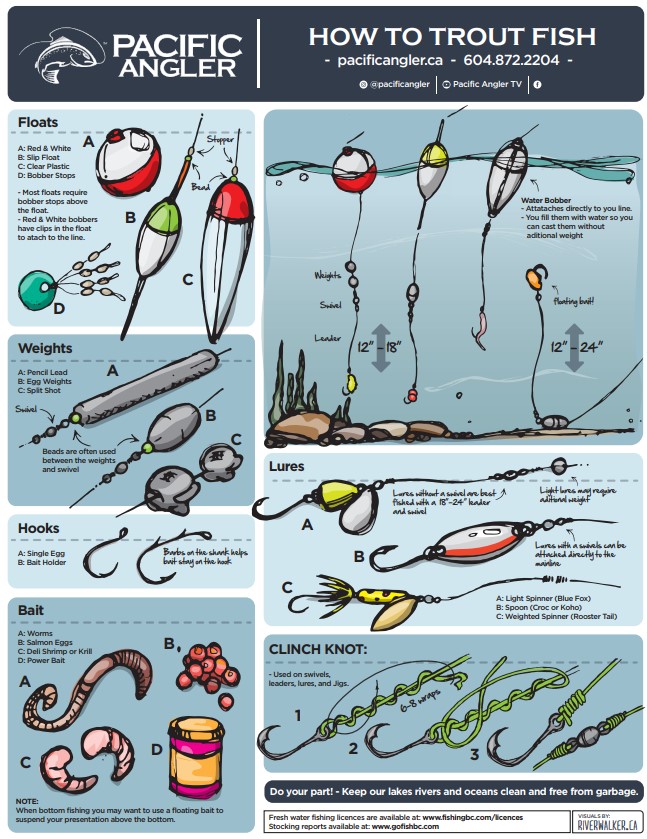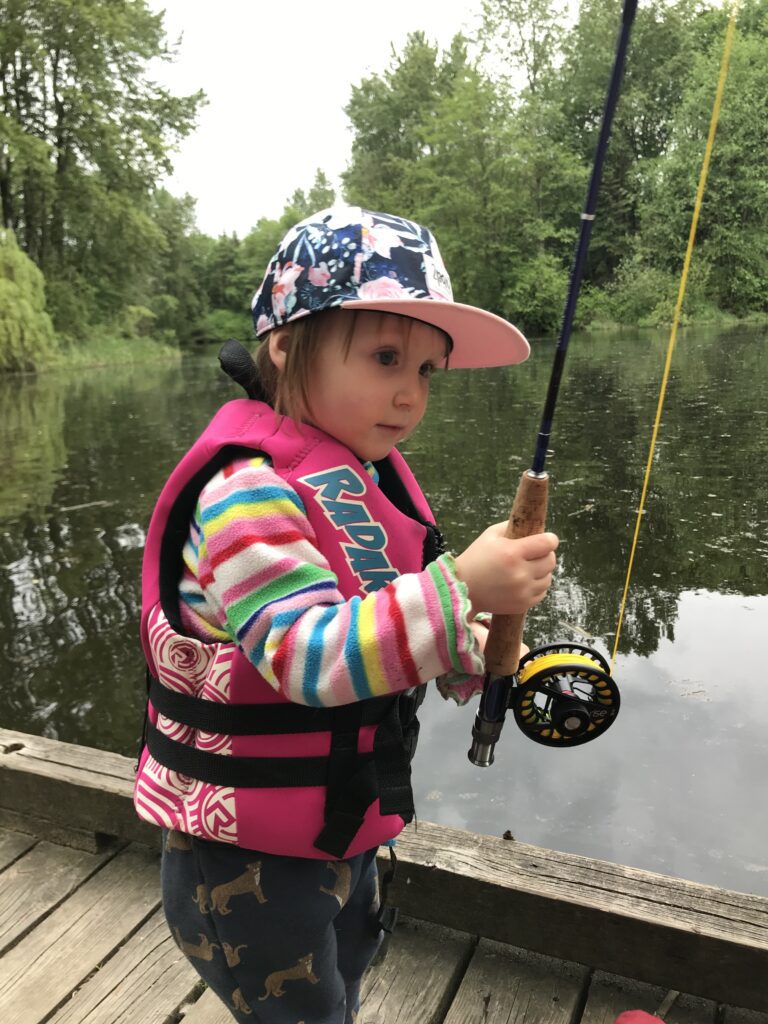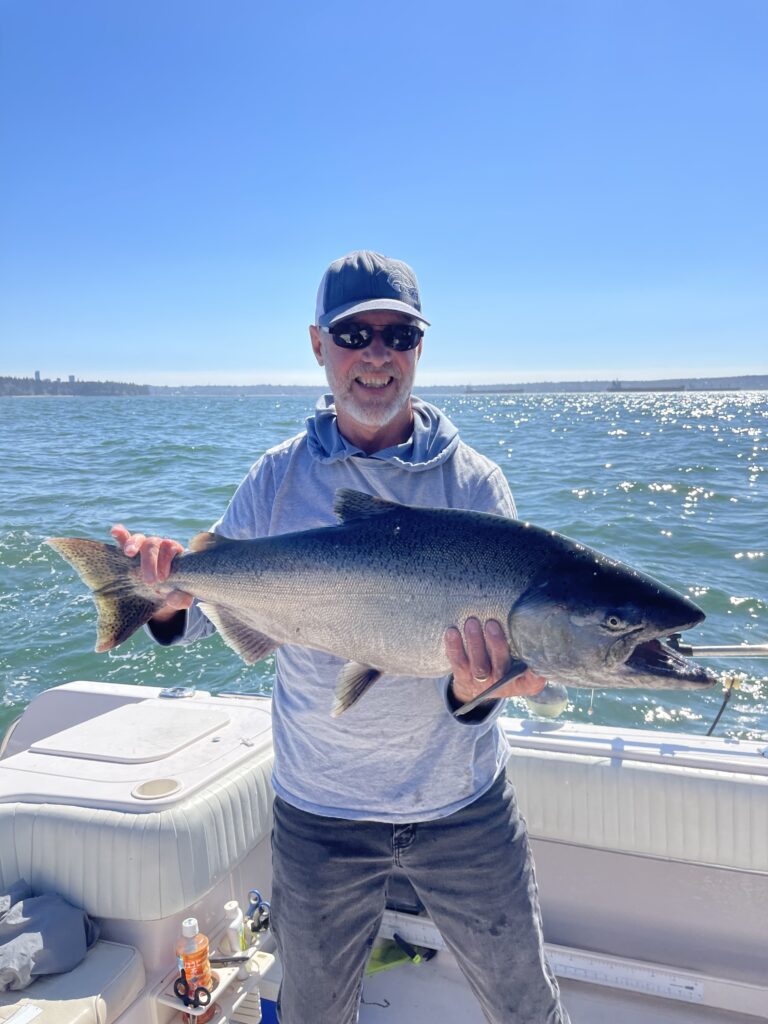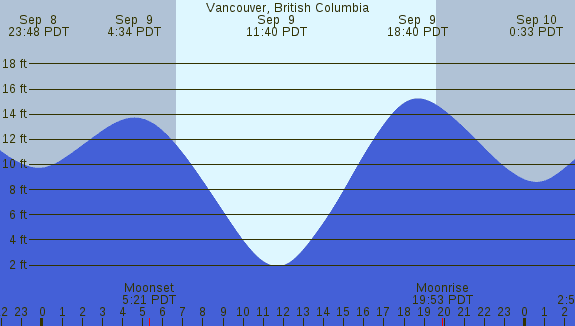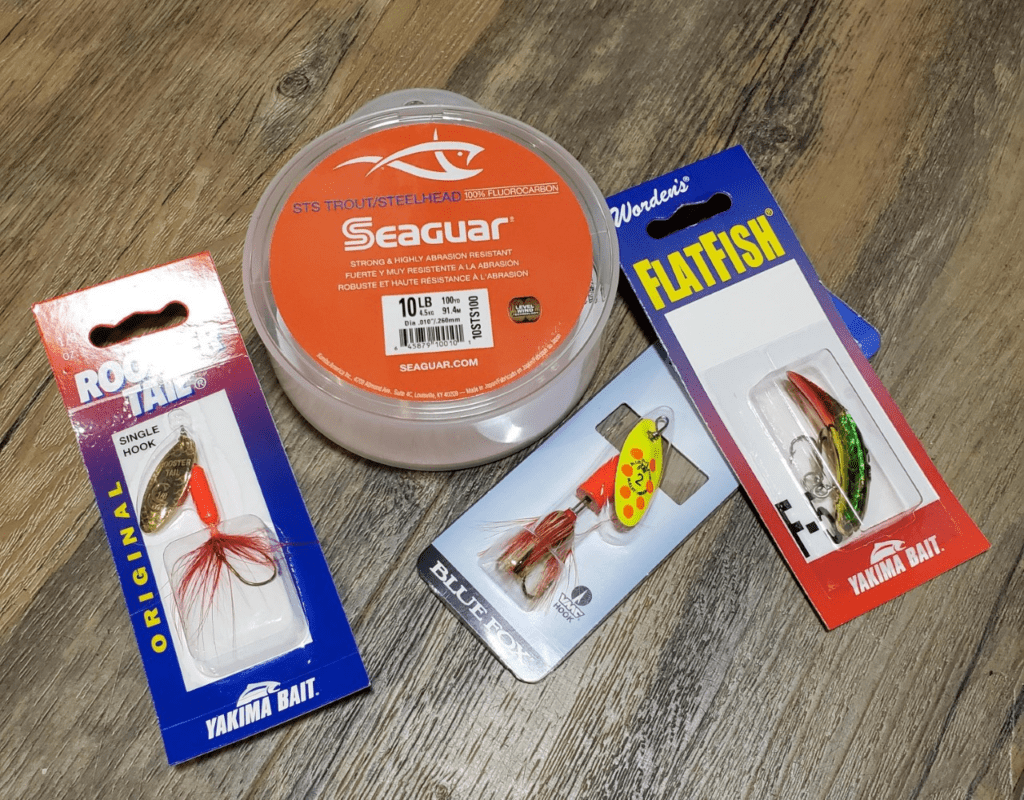OUTLOOK
Well, we thought the game was over in regard to the sockeye fishery but a late push of fish and some confusing DFO management decisions have resulted in an in river sockeye opening. So, you can fish in the tidal and non-tidal portions of the Fraser but you cannot troll off the mouth. Before you head out ensure you read both the Tidal Notice and Non-Tidal Notice . Jason has more details and thoughts on those openings and opinions below.
In other salmon river fishing news, we have a good one this week. Gavin goes over his top five float fishing presentations where he breaks out the leader board, walks through the different presentations, why you might use one over the other and more importantly where to use each setup.
With float fishing in mind, the reports from the Chilliwack are starting to come in and it is now worth getting out. Water levels are low but there are a good number of fish in the lower river. Taylor has details on what we have heard.
Last, but not least, the saltwater chinook fishing off the mouth of the Fraser continues to go strong and we have been blessed with a good late season. The weather was a little interesting this week and the commercial boats targeting sockeye are now out. We are not sure how both the heavy winds and the nets will affect chinook fishing. Be careful and respectful of the commercial boats and always check weather before heading out. Jason has details on the sockeye news as well as chinook updates at the end of the report.
The other fishery worth considering right now is the Capilano beach fishery. Tides are not great for fly fishing but they are pretty good for gear fishing. With low water and no rain in sight for the next 10 days, we should see more and more fish stack up. Jordan has some intel there in the saltwater section of the report.
It’s also a great time to take the kids out after school for a little local lake fishing. As temperatures drop many of our local lakes get stocked again and if you keep an eye on the Freshwater Society of BC’s stocking reports you can have some really good easy family fishing in September. Eric has details on this in the freshwater section for the report.
Finally, we have saved the best for last – our Fall Salmon Sale is back! Check out the industry and events section below for details on this upcoming sale.
INDUSTRY EVENTS AND UPDATES
Pacific Angler Fall Salmon Sale – Save The Date
We’re back with our Annual Fall Salmon Sale after a 2-year hiatus. Mark your calendars and come on down next weekend to save big!
2022 Sale Dates
Saturday September 17 and Sunday September 18
CLASSES AND COURSES
School is back and so are our fall classes! Call the shop at 604.872.2204 to sign up before they sell out.
INTRODUCTION TO FLY FISHING
This course was specifically designed to give the new fly fisher the basic knowledge, casting skills and fly fishing strategies to effectively fish our local BC waters. This course is comprised of two sessions; 3hr evening seminar and a 3hr casting session. The dates below show the seminar date first and casting date second.
Dates: Sept 20 & 24
Cost: $150.00
Zoom Seminar Time: 6:30pm – 9:30pm
Casting Time(s): 10am – 1pm or 1:30pm -4:30pm
INTRODUCTION TO FLY TYING
There is no greater satisfaction than catching a fish with a fly you tied yourself. This Introduction to Fly Tying course was specifically designed to give you the fundamental skills needed to tie proven fly patterns used here in BC for trout, salmon, and steelhead.
This course consists of 3 sessions; each session is 3hrs.
Students are required to supply their own vise, tools and materials. A 10% discount is available on fly tying materials and tools purchased for the course.
Dates: Sep 27, Oct 4, 11
Cost: $80.00+GST
Time: 6:30pm – 9:30pm
FALL SALMON RIVER FISHING: FLOATS, SPINNERS, & SPOONS
This 3hr evening seminar covers float fishing, spinner fishing and spoon fishing; the three most productive techniques to catch BC salmon in a river.
In-Person Seminar: Sep 26, 2022
Cost: $50.00+GST
In Person Seminar Time: 6:30pm – 9:30pm
FRESHWATER FISHING REPORTS
Fraser River Sockeye Openings & Opinions
The Fraser is open for sockeye. Love it or hate it, it’s open.
A last-minute increase in run size has triggered commercial openings off the mouth of the Fraser River and of course more First Nation opportunities in river via gill nets. Commercial and First Nation catches will be over a million fish by the time the dust settles with the vast majority of that going to First Nations.
The rest of us have been allocated a whopping 20,000 fish and the run is likely going to come in at around 6,000,000 so we get access to about 0.33% of it and you must fish in the Fraser.
That’s right, no trolling for sockeye off the mouth of the Fraser, but it’s open for 4 a day if you can figure out how to catch them in the Lower Fraser in areas 29-11 to 29-17, aka the tidal portions of the Fraser. That portion of the opening is a farce, as for 20 years people have been trying to catch sockeye in the lower river and have not been successful. The only consistent way to harvest sockeye in the Fraser seems to be bottom bouncing on gravel bars with long leaders where the fish are “flossed”. This is basically a refined snagging approach that has been used on the Fraser by anglers to harvest sockeye. The problem is there are no gravel bars that will work for this technique, pretty much below the mouth of the Vedder. So that makes the 4 a day limit in the lower river a joke as you won’t be able to harvest those fish in that area. The fish just don’t respond to spoons, spinners, jigs, bait, etc, with any consistency or at all and bottom bouncing is not an option. DFO has literally opened up an area and allocated a recreational harvest to an area where a fishery does not exist. Talk about gross miss management of a public resource.
The SFAB has pushed hard the last 48 hours with emergency meetings and motions for DFO to address this issue and have the mouth of the Fraser open to trolling techniques where the fish bite pink hootchies and can be harvested selectively. There are currently commercial seiners and trollers working these waters who will harvest over a hundred thousand fish but currently the public can’t fish there for sockeye. Meanwhile there are recreational anglers upstream of Mission Bridge harvesting sockeye at 2 a day and the gill nets are also being employed by First Nations. So why DFO does not open the river mouth to recreational trolling is beyond me. Seems to be open for all user groups in all other areas except there. To my knowledge this is the first time this has happened.
So, if you want to harvest some sockeye it’s 2 a day from Mission Bridge to Hwy 1 Bridge at Hope. That’s where the bottom bouncers will have access to gravel bars and I am sure it’s packed with people right now. If you want to fish below Mission Bridge in the tidal Fraser waters from areas 29-11 to 29-17 it’s 4 a day. Yes, that’s right, 4. But good luck catching them. If you figure it out you will have the place to yourself. Finally, if you want to troll for sockeye in the marine waters off the mouth of the Fraser, where they bite, you can’t. Luckily chinook fishing has been good to great off the Fraser, but it would be nice to see some logical and competent management of the resource and equal access to all user groups.
Jason Tonelli
Chilliwack/Vedder River Fishing Report
We’re into the second week of September, and we’re starting to hear reports of some springs and coho in the C/V system, as expected. It’s still early and the water is still very low and clear, so there aren’t tons of fish around just yet, and the fish that are around are quite skittish and concentrated in the deeper pools. As such, fishing has been a bit tough, with first light or last light being the most productive. The locals have figured out exactly where the best spots are, so expect fairly large crowds and heavy angling pressure in the most productive areas.
Having said that, going for a bit of a walk will usually pay off, as there will be some spots that have a “few” fish in them… they’re not “stacked” enough for the large crowds to descend upon, but they can still be productive and worth finding… if you don’t find fish, at least you’ll be away from the crowds and have an idea of where to go when we get more water.
The majority of the fish in the system are white springs, with a couple coho mixed in. As such, float fishing with bait, beads, blades or yarns should be productive. Casting spoons, spinners and twitching jigs can also be viable, but know that most fish will be stacking up in deep pools, so the likelihood of snagging fish can be fairly high if not done properly. Low water levels mean that a majority of the fish are in the lower river, so that’s where you’ll probably want to focus your efforts.
Fishing is still a bit slow, but remember that it’s still early in the season, so things can only really get better from here. Now is a good time to get out for a pre-season scouting trip while the water is low… might as well take a rod along and make it worth your time. I’d like to see a bit more water in the river, but it’s looking like that won’t be the case for a while. Having said that, the thing with springs is that they’ll still push into the system, even if it stays low; the issue is that low, clear water will make things tougher for us and the fish.
And finally, a quick word about snagging and flossing: Don’t.
FEATURE
Top 5 Float Fishing Presentation for Fall Salmon
As most of you know, the fall salmon season is upon us. In the next few weeks, ivory kings and silver slabs will fill our local rivers. Typically, there are 2 major ways to target our fall salmon with conventional gear: Float Fishing and Casting Lures. This week I will be going over my 5 G.O.A.T float fishing presentations for fall salmon.
R,B,B,J,Y – Roe, Beads, Blades, Jigs and Yarn.
These 5 presentations I believe cover 99% of the situations you will encounter while float fishing for salmon.
While all of these may work in the same scenarios/water, these presentations break down into two water classes: above walking speed and below walking speed. Typically yarn and beads will be utilized in the walking speed and above category, while roe, blades and jigs shine best in the walking speed and below category.
The reason why yarn and beads shine in faster water is because they are a small presentation that doesn’t get churned up in current like roe will. Faster current usually means fish have less time to inspect your presentation and will strike quick. Use a short leader for these as they should be kept in the zone in the faster water. Salmon have a natural instinct to strike small round objects while in faster water just like how a trout picks off nymphs in a stream.
Roe and jigs are key players in slower water. Roe has that magic scent trail and flow in the water that drive fall salmon crazy. Typically, roe shines best first thing in the morning and later on in the evening. With slower water, salmon have time to inspect and “check out” your presentation so using something more natural is best. For roe, I prefer a longer leader, so the roe flows naturally away from the weight. We could do a dedicated article on roe but some general rules are red colors are great for coho and chinook with more orange or naturals fishing well for steelhead.
Float fishing jigs have been a standard for the past 10 years and have proven to deserve a spot on the board. Jigs bounce, dance and prance with every ripple of current annoying holding salmon. Particularly deadly for chum and sockeye, something about a jig flowing at the same speed of the river put chum and sockeye in a trance. It is critical to maintain at least a foot above the bottom with your jig, in order to fish it effectively.
Last but not least, blades are very special to me, they are usually the last thing I will put through a run and usually always produce quality fish. Blades create a lot of flash, vibration and disturbance in the water that trigger salmon in in a slightly different way than a natural dead drift presentation. Out of respect towards other anglers, I tend to run the blades last as the same qualities that make it great, can quickly turn off a bite as the flash and vibration spook fish in the run.
Below is our float fishing diagram which will give some more direction on this fishery. As always if you have any questions swing by the shop or give us a call.
Give it a go,
Gavin Lau
FRESHWATER FISHING REPORTS
Local Lakes Fishing
Local lakes have been pretty quiet the last few months. The summer heat and lack of trout stockings can make for some tough fishing, but we do have some good news. With September usually comes the first batch of fall trout. Historically we see some of the most popular lakes being stocked around the 3rd week of September. First stockings are usually Rice Lake, Lafarge, and Green Timbers, with surrounding areas like Ioco, Abbotsford, and Maple Ridge stocked soon after. The stocking program will continue through to the 3rd week of October providing anglers plenty of opportunities to catch these fish.
After the lakes are stocked you can catch these aggressive fish on a number of presentations. I have a quick list of our top three methods to catch stocked trout.:
Float fishing is simply suspending a sinking bait in the water column using a float. Large floats allow you to use more weight and to cast father. Smaller floats are more sensitive to detect bites but might be difficult to cast a long distance. Worms, shrimp, and salmon eggs are some great baits to try.
– Bottom fishing is casting out a weighted rig with floating bait. The weight rests on the bottom and from a leader you have a hook with floating bait. The bait is suspended above the bottom making it a popular choice when the fish might be deeper in a lake. Floating power bait, and power eggs work well for this.
– Spinners and spoons work great when you have aggressive fish around. Remember to keep your presentations suited to the size of fish you’re after. Change your retrieve speed to get different actions from your lures, and cover water.
Oh Yeah Flies!
Fly fishing stocked lakes is a fun and rewarding way to bend a fly rod. It will take a little time to understand how to catch fish on your specific body of water but persistence usually pays off. If you are first starting out, look for lakes with dock access. Casting flies, or indicator fishing can usually be done on the dock, but always be careful as the docks can be crowded. A small boat or watercraft can really help. Trolling a mix of leeches and buggers is a simple productive method of finding fish. Favorite stocker trout patterns include leeches and pumpkin heads in green, olive, brown, black and burgundy. Balanced leaches and chironomids can be fished under an indicator.
We also have a fresh stock of Outcast float tubes and inflatables in store! Float tubes allow fly and gear anglers access to the entire lake. These boats provide casting room on busy lakes, and help anglers reach fish far off shore. This can be essential when shore access is limited by trees or weeds. Float tubes are convenient and portable. Comfortable enough to fish in all day, but still small enough to fit in a car, or condo closet. Stop in the shop to see the full range.
Cheers
Eric Peake
SALTWATER FISHING REPORTS
Vancouver Saltwater Salmon Fishing Report
If you are wondering about sockeye, you can read my report in the Fraser River Sockeye Openings & Opinions piece, but in this report, I am going to focus on chinook and coho.
Opening day and the 72 hours after it were fantastic for chinook at the Bell Buoy, Iona Jetty, T-10, and South Arm. There were a lot of fish around and the catches were great. In last week’s report I covered in detail hot depths and tactics and those held true this past week. In short, if you were fishing flashers, teaser heads, and herring or anchovy in the top 70 feet of the water column you would have done well.
The orcas did come through on Sunday and Monday and that did slow things down temporarily. Fishing did pick up again early in the week and the fish were safe on Wed with the 30 plus knot winds. Fishing yesterday and this morning has been good again and should continue to be solid in the coming days.
In terms of the mix, the whites are in full force now and their numbers will increase into next week. The same can be said for hatchery coho. More will show over the next 2 weeks, mostly Vedder fish. The 14-day forecast shows very little rain, so unless the orcas really come in hard the next few weeks, I think fishing will be good.
The Cap has also had a few fish, among other spots close to home. Most of us have been fishing the mouth of the Fraser but on shorter trips we have had some good fishing for chinook and coho off Point Atkinson, the Cap Mouth and the Bell Buoy. Eddie had a great day at the Bell yesterday and was the only boat there. Seems this once packed spot has been somewhat forgotten about this time of year. It is close to the SRKW management zone, but if you fish from the Bell to the Mile Markers you are good. There are some Fraser bound fish here but you also get some fish headed to the Cap. So, if it is too windy to venture out of the harbour, give this spot a try.
See you in the shop or on the water,
Jason Tonelli
Beach Fishing Report
The Beach has continued to reward those who are persistent and managing to get out as much as possible.
This weekend has some good tides again, with big ebbs creating opportunities for getting out to the sandbar mid-morning and onto the afternoon.
Though we haven’t heard of any crazy reports of gang-buster days, anglers are still touching fish on the incoming tides. When not visible, blind-casting and sending wishes is more often than not how we fish this beach. That said, the stars can align on some days making the fish bold and visible, making accurate and precise casting a requirement.
Small spinners, spoons, and flies are all great choices for trying to tempt these tight-lipped fish, but don’t be scared to fish bait off the bottom on a slip-rig.
With Capilano chinooks, a good number of them will sit lower down in the water column, often right on the bottom where the current is weaker and they can stage and forage. A small anchovy or herring can sometimes be the easy meal these fish are looking for as they conserve energy for their final expedition.
Jordan Simpson


